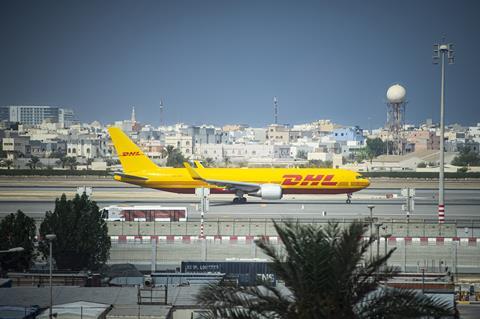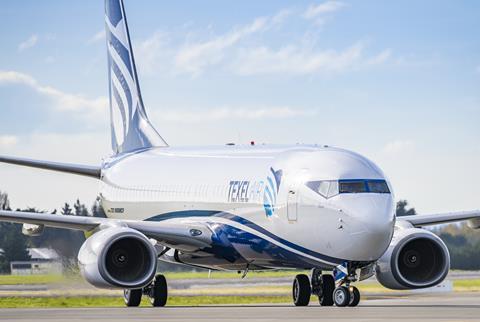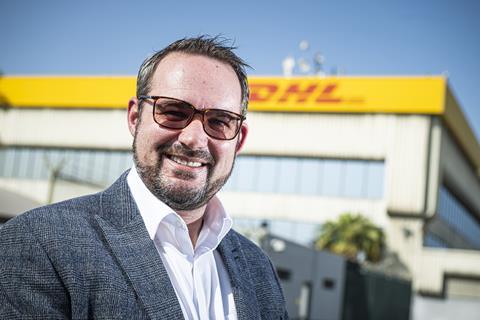The kingdom is a leading hub for air freight and infrastructure investments at the airport are set to consolidate its status as a global crossroads
Just as the Suez Canal is a major artery for global shipping, so a significant proportion of the world’s air cargo that originates in China and Southeast Asia and is destined for businesses and consumers in Europe and North America travels through the Middle East.
In the same way as they have used their geographical advantage to develop giant passenger transit hubs, several of the Gulf’s airports market themselves as strategic staging posts for air freight operators.

They include Bahrain, which wants to build on its long relationship with German parcels giant DHL and easy access between its airport and seaport to increase its share of this global trade. Like its Gulf counterparts, it also feels it can tap into a growing regional market for e-commerce, particularly in next-door Saudi Arabia and the United Arab Emirates.
DHL’s Boeing 767-300 freighters, with their distinctive yellow paint scheme and red logo, are a familiar sight at the airport. Bahrain is one of the company’s four international hubs. The airport is also home to fast expanding narrowbody operator Texel, as well as MENA Cargo, which is 49% owned by Singapore’s Asia Cargo Network.
Meanwhile, FedEx Express, which has had a presence in Bahrain for more than 30 years (although its Middle East nerve-centre is at Dubai South), has recently moved in as the first tenant of a new express cargo village that airport operator BAC is developing on the north side of the runway. With phase one of the project complete, BAC plans to announce details of the second phase before the end of the year.
DHL’s Bahrain-based fleet has almost doubled in size since the turn of the decade when it had six 767-200s under its local air operator’s certificate (AOC). Today, helped by the boost pandemic stay-at-home mandates gave to e-commerce, that has grown to 10 newer 767-300s, with the fleet supplemented by two 737-800s on wet lease from Texel and painted in DHL colours.
There are two main drivers behind the growth, suggests vice-president aviation Richard Gale. The first is that almost no Western-registered aircraft have been able to over-fly Russia since routings changed after the start of the Ukraine conflict. This has made it more convenient for long-haul air freight to route through the Middle East.
A second factor is that “this part of the world is really emerging when it comes to e-commerce”, says Gale. While Bahrain remains primarily an air freight hub for consolidating items destined for other continents, 20% of all consignments arriving in the country from the East are for recipients in Bahrain itself or parts of Saudi Arabia that can be reached by road (Bahrain is connected to its much larger neighbour by the King Fahd Causeway).
Gale says DHL’s original intention was to simply replace its half dozen 200s with newer -300s. However, sustained high demand after the pandemic prompted it to add four more – eight of its new aircraft are owned with the other two dry-leased from ATSG. The -300s – all ex-American Airlines passenger aircraft – are around half the age of its former 1980s-era -200s.
The younger, larger aircraft have “completely changed the game for us”, says Gale. “We never before had to be concerned with ETOPS [extended-range twin-engine operations approval, which allows twinjets to fly a route that involves being further than 1h flying time on one engine from an alternate airport].”
In terms of range, the -300s “can push” 9h flying time at 60t, as opposed to around 6h at 40t on the -200, so effectively doubling the previous capacity. “It means the destination portfolio has been flipped on its head,” says Gale, with the Bahrain-based aircraft now flying twice-daily to Hong Kong, daily to Singapore, Milan, Leipzig and Nairobi, and three times a week to Bangalore.
DHL Aviation’s Bahrain-based business also connects with its sister DHL air operations: a 777 arrives daily from its sister hub in Cincinnati. The Texel 737s give it a more cost-effective option for flights to other Gulf destinations and as far as Beirut and Turkey. “The relationship with Texel keeps it simple as we both have the same regulator,” says Gale.
DHL’s current Bahrain headquarters shares a building with its airside cargo consolidation centre – getting to Gale’s desk involves traversing a walkway over loops of conveyor belts filled with packages. However, the plan is to build new offices which will be ready by January 2028, leaving the current premises as the automated distribution hub. Gale is hoping to include on-site passport-control facilities to save time for pilots, who currently must go through the main airport terminal.
Heads of agreement have also been signed with the airport to build a line-maintenance hangar large enough for two 767-300s or a 777X – “We’re future-proofing,” says Gale, who adds that the roughly $85 million investment is “the final piece of cement in our presence in Bahrain”.
DHL employs 150 pilots in Bahrain out of a total staff of 380. Although Gale admits that the pilot market has tightened in the past year after the dearth of experienced flightcrew seen in the immediate recovery from the pandemic, he says that working for a cargo airline is still a highly attractive job for many.
“It depends what people want to do,” he says. “If they want a quieter life, flying 45 to 50 hours a month, then this job is ideal. If you work for a major airline, you might be flying 100 hours. So, if your objective is to boost your hours as a first officer and reach captain, then we are probably not right for you.”
Right now, Gale is entering his busiest season of the year as the Christmas season and Chinese New Year approach, and people start stepping up their spending on e-commerce. This month and next services to Hong Kong will step up to four times daily. “It’s at times like this that it becomes clear that we are right in the middle of one of the world’s biggest trade routes,” he remarks.
TEXEL SPECIALISM
Over on the north side of the runway, Texel – a Bahrain-based airline founded by New Zealander John Chisholm in 2013 and run by his son George – deals largely with another aspect of the air freight market: specialist charters. It is, however, also involved in the parcels market, via its wet-lease relationship with DHL.

It operates three 737-800BCFs (Boeing Converted Freighters), two of which are under contract to its neighbour, as well as two 737-700 FlexCombi hybrid passenger/cargo aircraft from Pemco World Air Services. The flexible layout combines a cargo area with a passenger cabin that can be configured for 12 or 24 passengers, perfect, maintains George Chisholm, for niche jobs such as equine transport or transporting specialist machinery, where teams travel with the load.
At the last air show, Texel displayed on its stand an in-flight horse box – complete with life-size plastic racehorse – to promote its increasing presence in this highly niche segment: the sport is enormous in the region and many wealthy Gulf Arabs have their own animals or stables. The timing was apt as the racing season begins in November and runs until June.
Texel became the launch customer for the FlexCombi when it took delivery of the first example in 2020 – the second followed a year later. The Bahrain company had worked with Tampa-based Pemco on achieving US Federal Aviation Administration approval for the programme.
While Texel is phasing out an older 737-300, Chisholm hopes to add a fourth -800 on the Bahrain AOC, depending on market demand. The oil and gas market has been lucrative, where the volume offered by the 737-800 is crucial for the large pieces of equipment that need to be transported.
For many of the 737-800’s customers in this segment, time and reliability rather than maximising payload are key, says Chisholm. A lighter load means the type can reach Bahrain from Phuket in Thailand, for instance, without a stop, and can continue to Europe after refuelling and switching crew. “It makes the -800 a really efficient charter vehicle,” he says. “The aircraft has given us new options.”
Chisholm says its ACMI (aircraft, crew, maintenance and insurance) agreement with DHL provides steady income from the scheduled services it flies, “plugging the gaps” regionally to allow DHL’s widebodies to focus on intercontinental routes. “We are very happy to have DHL as a customer,” he says. “It’s a big thing for us as a group.”
Texel, which has its own hangar and headquarters on the airport perimeter which it has recently expanded, will not be moving to the new cargo village. “We’re not really in the [e-commerce] business,” says Chisholm. However, he is confident of picking up ad hoc business from tenants there once the development is up and running.
The company operates the largest maintenance facility at the airport, providing Part 145 services for its own fleet and third-party customers. It also offers parking and tooling rental services.
Chisholm Enterprises, which owns Texel, has also taken the Texel brand beyond Bahrain, establishing an AOC in New Zealand. Because of a bilateral agreement with its neighbour, the AOC allows the Auckland-based entity to operate freight services within Australia, a more lucrative market.
Texel Air Australasia operates five 737-800s and won a seven-year contract in June this year with parcels and logistics firm Team Global Express, under which it will operate three aircraft in its customer’s colours and one in the Texel livery. It is also operating internal New Zealand services between Auckland and Christchurch for a local parcel operator as well as some charter flights.
In October, Texel’s New Zealand subsidiary announced it had completed the first EDTO (extended diversion time operations) 120min flight on a 737-800 BCF between Melbourne and Perth on behalf of Team Global Express. It follows Texel’s approval of EDTO 120 flights from the New Zealand regulator. Earlier this year the FAA gave the green light to the 737-800BCF to fly ETOPS flights of up to 180min.

ETOPS and EDTO capability are needed to both fly across the Australian continent and the Tasman Sea. John Chisholm, who is chairman of Chisholm Enterprises, says the “really important” development for the business will also allow it to open new routes, including to remote south Pacific islands.
BAC says it is investing BD24 million ($63 million) in the 25,000sq m (269,000sq ft) cargo village, which comprises 10 modular warehouses, 19 business units, and aprons. Logistics is one of several high-growth sectors identified in Bahrain’s 2020 Economic Vision strategy and BAC says the cargo village will be one in a series of infrastructure projects across the country.
The cargo village will have a road link to the nearby Khalifa bin Salman container port, making it easier for freight forwarders to ship heavy consignments from East Asia and then have them broken up for air freight. This, claims Bahrain’s government, allows shippers to save time and avoid the potential bottleneck of the Suez Canal. A 30min drive in the other direction will take trucks to the King Fahd Causeway, entry point to Saudi Arabia.


























